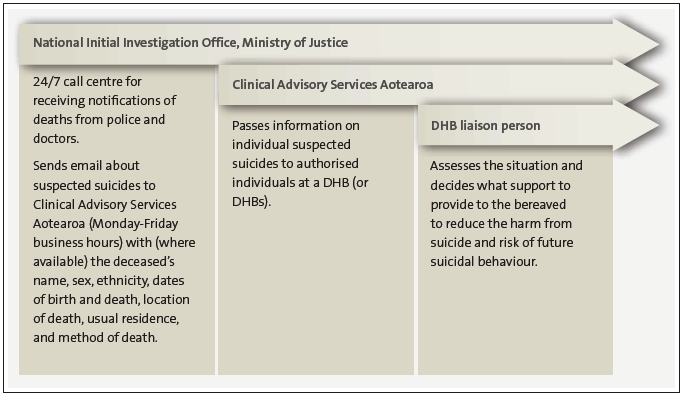Part 3: Local responses to suicides
3.1
In this Part, we look at how information is used in the period immediately after a suspected suicide. We discuss:
- the rapid advice system for notifying DHBs of suspected suicides in their area, and how they should respond; and
- the steps being taken to identify emerging suspected suicide trends.
Rapid advice system and local responses
3.2
A nationwide rapid advice system for responding to suspected suicides has been used since January 2015. It is called the Coronial Suspected Suicide Data-sharing Service. It aims to give DHBs an early opportunity to reduce the harm that suicide causes in the community by providing support to the bereaved. This support is considered to be a form of suicide prevention because it also aims to decrease the risk of self-harm by the bereaved.
3.3
Several agencies have a role in the Coronial Suspected Suicide Data-sharing Service:
- the National Initial Investigation Office (NIIO), Ministry of Justice;
- DHBs;
- the Ministry of Health; and
- Clinical Advisory Services Aotearoa, which is a community organisation.
3.4
The Chief Coroner and the Ministry of Health have signed an agreement with each DHB for the service. The Ministry has the contract with Clinical Advisory Services Aotearoa for its work. Figure 2 summarises each party's role and how they interrelate.
Figure 2
Overview of the Coronial Suspected Suicide Data-sharing Service

3.5
The Ministry of Health has explained to DHBs what support they are expected to provide after a suspected suicide. Briefly, possible support includes:
- crisis response services;
- specialist grief education programmes; and
- guidance and advice prepared by the Mental Health Foundation of New Zealand.16
3.6
DHBs must also have plans to respond rapidly to a potential "suicide cluster". Suicide clusters are rare events in which multiple suicides or suicide attempts occur closer together (in terms of time, area, or people's social connections) than would normally be expected. Suicide clusters may lead to wide community concern and increase the risk of suicidal behaviour (this is known as "suicide contagion").
3.7
The Ministry of Health has said that DHBs should have working relationships with important community stakeholders (such as educational institutions, New Zealand Police, social services, and Victim Support or Kia Piki te Ora) to create a base for effective responses. We agree that such working relationships are important.
Next steps
3.8
We did not audit how well the rapid advice system is working. We encourage the Ministry of Health to get assurance that DHBs have effective systems for considering and responding to information they get from the NIIO and Clinical Advisory Services Aotearoa.
3.9
The methods used by emergency planners could be adopted by the Ministry of Health and DHBs to test the common understanding of how the DHBs' plans are working or would work. Various types of exercises could be used and it is good practice to start with the simplest exercise first, such as:
- a test with an element of passing or failing – for example, testing that messages from the NIIO and Clinical Advisory Services Aotearoa are received by the right people within the expected time;
- a walk-through exercise, which is a simulation where participants review and discuss (not perform) the methods, procedures, and resources associated with activating each part of the response plan;
- a table-top exercise, where each DHB and other agencies carry out the response plan verbally; or
- a live exercise, which could involve suspending normal services.
Identifying emerging suicide trends
3.10
Clinical Advisory Services Aotearoa analyses data received through the Coronial Suspected Suicide Data-sharing Service to identify any emerging trends, for example in methods being used or potential clusters. If emerging trends are found, Clinical Advisory Services Aotearoa is to alert the appropriate DHBs and the Ministry of Health. If there is doubt about whether a trend is emerging, the Ministry can be contacted for advice.
3.11
The Ministry of Health told us that the Coronial Suspected Suicide Data-sharing Service has been useful – as it expected – for telling communities and government agencies the facts when there are misunderstandings about the number of recent suspected suicides in an area.
Conclusions
3.12
Since January 2015, there has been a nationwide system for the Ministry of Justice to give rapid advice to DHBs about suspected suicides in their area. To reduce the harm caused by suspected suicide, the Ministry of Health expects DHBs to provide suitable support to the bereaved. We encourage DHBs to ensure that they have the necessary relationships with stakeholders to provide effective support after suspected suicide. We encourage the Ministry of Health to get assurance that DHBs' responses meet an acceptable standard.
3.13
The Ministry of Health has contracted a community organisation to watch for emerging suicide trends, and DHBs must have response plans in place.
16: More details about the DHBs' expected response is in the Ministry of Health's Suicide Prevention Toolkit for District Health Boards, Appendix 1, www.health.govt.nz.

